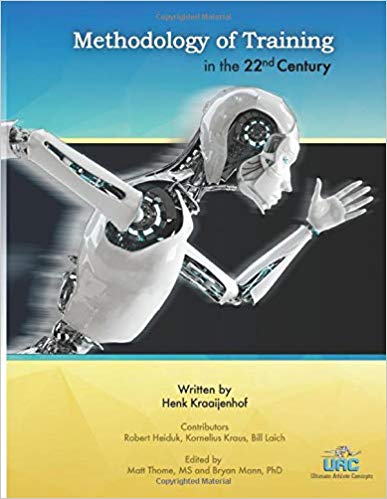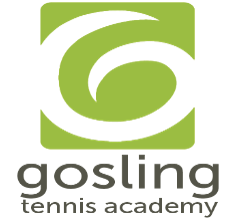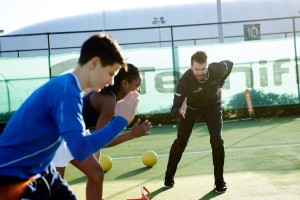Hi Everyone,
it’s been a while since I’ve done a book review but I have recently been reading a book that has been really interesting and I wanted to share it with you. It is called ”Methodology of Training in the 22nd Century” written by Henk Kraaijenhof.
I actually have a few chapters to finish (there are 12 in total) but I really wanted to focus in on a particular chapter that will have meaning for you whether you are business owner, athlete or coach.

For the first 10 years of my life as a coach I invested nearly all of my time learning about the science of training in elite sport. For the last 10 years I have continued to do that while also navigating the new frontier of commercial sport and all that it entails. One chapter in particular was a great overview of the balance between the two settings of science and capitalism.
As a coach first and foremost I want to learn about the best approaches to train someone to achieve the highest levels of performance in competition. As a business owner I have had to wrestle with the idea and later accept that it won’t always be the best method (the one that gets evidenced results time and again!) that is the most popular- it’s the one that is best marketed.
I think Chapter 2 did a great job of describing this state of affairs.
Chapter 2- Sociocultural Backgrounds of Modern High Performance Training
Sport and Performance
Modern sport has its roots in capitalist industrialization. The desire for performance lead to the need for recording the results and the birth of records in sport. Different sciences analyze from different perspectives (with the ultimate goal to maximise performance leading to improved results).
Biomechanics- performance is regarded as a physical value of power (P), which is the amount of mechanical work accomplished in a given time.
Exercise physiology- proves relationships with biological reactions of the organism.
Science of training- the original science and focuses on a systematic approach to training, based on the demands and results of the competition.
Setting of Modern Elite Sport
High performance sport was a political goal and science was the instrument to realise this goal. Elite athletes were often called ”diplomats in tracksuits.”
Until the end of the East-West conflict, the funding of sports at the elite level was completely established by the government in all successful Eastern European countries.

The centralised socialist planning was able to ensure a foundation for controlling long term performance development from kindergarten to the the Olympic level. For the German Democratic Republic (GDR), a country with only 16 million citizens to win 102 Olympic medals in the last Games in Seoul in 1988 was a prime example of the efficacy of the whole sport system.
Methodologies without evident effects had to be excluded.
The system of the GDR worked because of its systematic quality, relying on a centralised network of controlled processes that were in line with a long-term approach.
After the end of the cold war, elite sport was no longer needed as a political instrument and the governments in Europe gradually withdrew their involvement in elite sports.
Now we have a high performance sports system which acts as a entertainment sports network with globalised economic dependencies and the breakup of the national state. The task of the modern professional athlete is no longer (only) striving for the highest performance in competition. In fact, it is of comparable importance to achieve a high amount of public attention aside from the sport, because the modern athlete is treated as a product, aimed to be sold at the highest possible price on the market.
The Olympic movement was an idea for amateur sport, but after the end of the political east-west conflict, the Olympics were fully embedded into the capitalist idea of profit and professional athletes were accredited to compete. The sociological perspective reveals that, in modern elite sports, maximising competition results or sports performance seems to be secondary to maximising profit.
Sports Performance Training as a Product
Today, sports performance training is offered increasingly as a service by a variety of providers, leading from single people to big companies.

A successful business model in the sport performance market relies strongly on good networking and marketing rather than on a sophisticated training approach.
It’s about a subjective assessment of being in good hands and not on the verification of the contribution to competition results of the given service.
The practice of sport is used to express a certain kind of lifestyle. In a highly commercialised society, consuming products or services are strongly related to a lifestyle. The lifestyle is a product-related image, created by the industry in order to sell an imaginative new self-identity.
McDonaldization of Training Methodology
This term refers to the concept of standardised mass production made famous by pioneering American companies like McDonald’s and Ford. The coordination and the control of the training processes in elite sport are based on the same logic.

The main goal is always to find the most efficient, logical and reproducible way to reach a goal. Features of McDonaldization include:
- Efficiency- optimum training methodology with best possible cost-benefit ratio
- Computability- quantifiable parameters
- Predictability- clear time structure of training planning
- Control- monitoring of training parameters
But there are a number of side effects of McDonaldization in training methodology.
- Template methods
- Mechanistic approach- more is better
- Inflexibility of approach in spite of the fluidity of biological and environmental changes
- Automation and deskilling of expertise- dehumanization through rapid adoption of technology
The organisation of businesses geared towards making money always leads to standardisation. In every McDonald’s restaurant all over the world, every hamburger equals the other, as well as the ingredients, preparation and sales. Any systematic approach requires a certain degree of standardisation in order to increase the likelihood of getting the desired results in a specific timeframe. This is why planning of training also relies on standardised parameters, but there are limitations to this approach.
From a biological point of view, there is nothing like an average or standardised individual- either on an anthropometric, metabolic, neural, nor on a personality level. Unlike in a McDonald’s franchise optimal training results:
- can be achieved from different starting positions
- can be complete despite incomplete or variable training stimuli
- allow margins within which it is possible to reach the same effects
The goal of McDonald’s is not to produce good hamburgers, the goal is to sell many hamburgers.
Considering performance training services in modern sport as a business, the same principles apply. Standardisation becomes very apparent via the rising popularity of exercise orientation in the training methodology of athletes. Exercise orientation implies that the characteristics of the equipment or the methodology itself are the foundation of the training approach and not the demands of the sport or the needs of the individual athlete.
Without exercise-orientation, McDonaldisation is impossible. Tailor made training is exactly the opposite.
Therefore it is logical that in a gym, everyone is doing the same thing based on uniformity of the facility designs, the equipment orientation of the methodology, or the subjective bias of the coaches, led by the latest fads.
Generalisation is the core concept of marketing and, in order to become commercially successful, it requires serial production and no individualisation.
The bias a coach has for a particular methodology seems to be derived from subliminal mechanisms of the commercial market, rather than on individually based sports profiling
In summary, this behaviour is typical for a complex highly differentiated society where McDonaldisation is the only possibility. In a McDonalised society, people rarely seek the best means to reach a goal- instead they fall back on popular means.
It is suggested that methodology of training in high performance sports should NOT accept and represent the principles of McDonaldisation too much. The prevalence of standardization leads to uniformity like the ”template method.”
Therefore, it has to be questioned whether a humanistic high performance sport is possible in a McDonaldised society, as McDonaldisation contradicts the essential characteristic of every competition and game: unpredictability, the essence of human life.
Where I am next presenting?
Level 2 Certificate in Strength & Conditioning

Dates: 11/12 Jan and 15/16 Feb 2020, 09:00AM-17:00PM Location: Gosling Sports Park, Welwyn Garden City, AL8 6XE
Book your spot HERE
Hope you have found this article useful.
Remember:
- If you’re not subscribed yet, click here to get free email updates, so we can stay in touch.
- Share this post using the buttons on the top and bottom of the post. As one of this blog’s first readers, I’m not just hoping you’ll tell your friends about it. I’m counting on it.
- Leave a comment, telling me where you’re struggling and how I can help
Since you’re here…
…we have a small favor to ask. APA aim to bring you compelling content from the world of sports science and coaching. We are devoted to making athletes fitter, faster and stronger so they can excel in sport. Please take a moment to share the articles on social media, engage the authors with questions and comments below, and link to articles when appropriate if you have a blog or participate on forums of related topics. — APA TEAM
=> Follow us on Facebook
=> Follow us on Instagram
=> Follow us on Twitter













